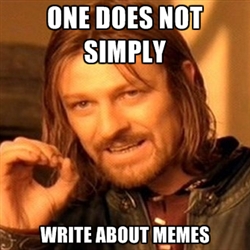|
Call for Submissions: Internet Memes and Visual Culture A themed Special Issue of Journal of Visual Culture Issue Guest Editors: Laine Nooney (Stony Brook University) and Laura Portwood-Stacer (New York University) The Editors are currently seeking proposed contributions for a Special Issue of the Journal of Visual Culture on Internet Memes and Visual Culture, to be published December 2014. The term meme, a portmanteau of mimesis and gene, was minted in 1976 by British ethologist and evolutionary biologist Richard Dawkins. Dawkins proposed the meme as a “unit of cultural transmission,” a self-perpetuating cultural phenomenon analogous to the gene as a replicator of biological data. Almost 40 years later, the term “meme” has become the coin of the realm within Internet subcultures, particularly on microblogging and social network platforms. In these contexts the designation “meme” identifies digital objects that riff on a given visual, textual or auditory form. For a digital object to become a meme, it must be appropriated, re-coded, and slotted back into the Internet infrastructures it came from—memes require continued user adaptation. Thus, memes are co-constitutive with the user practices of creative (re)production that are default modes of communicative interaction on major social media platforms such as Facebook, Tumblr, Reddit, Twitter, Pinterest, and YouTube. Memes are frequent objects of analysis among scholars of contemporary digital culture, socio-linguistics, fan culture, and social networking, wherein they are assessed as forms of generative vernacular communication and art-making that defy traditional models of top-down capitalist consumer control of mass media forms. Yet the speed, volume and insularity of meme-making often frustrates aesthetic, formal and techno-infrastructural scholarship on memes and meme distribution.
This special issue of the Journal of Visual Culture will organize a conversation among cultural scholars, artists, activists, journalists and Internet content producers regarding the social, historical, and aesthetic significance of Internet memes. Our move to “take memes seriously” as communicative and aesthetic objects is especially timely, as memes' linguistic tropes, visual styles and means of transmission gain increasing visibility beyond their origins in online subcultural spaces such as 4chan or 9gag. One of the ways this special issue will take on these questions is by itself expanding on traditional modes of academic writing. Potential contributors are thus encouraged to incorporate visual and conceptual experiments intended to elucidate the meme form, performatively and materially replicating the phenomenon under study. Suggested Topics The Editors are open to engagements with “Visual Culture” broadly writ. Contributions may consider the following topics or expand on other ideas, keeping a particular emphasis on relating memes to the visual:
Current Contributors
Submission Guidelines For a proposed academic paper, please email a single-spaced, extended abstract of 1000-1200 words that details a projected argument and possible example cases to be examined. Please also include a brief list of scholarly sources that will inform your paper (not included in the word count). For a proposed contribution in another formats (short essay, graphic essay, conceptual piece, etc.), please email a single-spaced description or artist statement that details the format and projected content of the submission. The deadline for submission of proposals/abstracts is 15 January 2013. The Editors expect to make final decisions about accepted contributions by mid-March 2013. Accepted contributors will be asked to submit their full contributions by January 2014. The Editors are aware of and open to shifts in content that may occur as the full submission develops, should the proposed contribution be accepted for inclusion in the issue. Inquiries and submission proposals should be directed to both Laine Nooney (laine.nooney@gmail.com) and Laura Portwood-Stacer (lportwoodstacer@gmail.com). Emails should include the subject heading: Internet Memes special issue, JVC. Comments are closed.
|
Archives
March 2020
Categories
All
|

 RSS Feed
RSS Feed